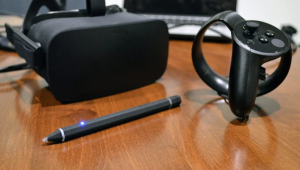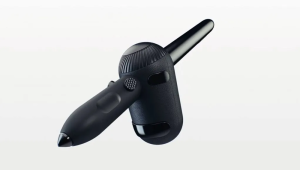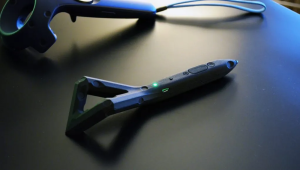3D stylus: Difference between revisions
Xinreality (talk | contribs) No edit summary |
Xinreality (talk | contribs) No edit summary |
||
| Line 1: | Line 1: | ||
{{see also|Terms|Technical Terms}} | {{see also|Terms|Technical Terms}} | ||
{{see also|Accessories|VR Accessories|Input}} | {{see also|Accessories|VR Accessories|Input}} | ||
A [[3D stylus]] (sometimes called a '''VR pen''' or '''spatial stylus''') is a pen-shaped input device that tracks motion in three-dimensional space, providing six degrees of freedom (3 | A [[3D stylus]] (sometimes called a '''VR pen''' or '''spatial stylus''') is a pen-shaped input device that tracks motion in three-dimensional space, providing six degrees of freedom (3[[DOF]] position + 3DOF orientation). It enables precise pointing, drawing, and manipulation tasks that would be awkward with bulkier [[motion controllers]] or bare-hand tracking.<ref name="RoadToVR18"/> | ||
[[File:MasslessPenVRStylus1.png|thumb|The **Massless Pen** 3D stylus used with a VR headset<ref name="RoadToVR18"/>]] | [[File:MasslessPenVRStylus1.png|thumb|The **Massless Pen** 3D stylus used with a VR headset<ref name="RoadToVR18"/>]] | ||
Unlike a traditional 2D stylus confined to a tablet surface, a 3D stylus operates freely in mid-air (or against any physical prop) and often incorporates buttons, a pressure-sensitive tip, and haptic (vibrotactile or force) feedback.<ref name="CreativeBloq21"/> Some high-end | Unlike a traditional 2D stylus confined to a tablet surface, a 3D stylus operates freely in mid-air (or against any physical prop) and often incorporates buttons, a pressure-sensitive tip, and haptic (vibrotactile or force) feedback.<ref name="CreativeBloq21"/> Some high-end models, such as the [[Massless Pen]], achieve sub-millimetre accuracy by fusing optical tracking with inertial measurement units (IMUs).<ref name="Tomshardware21"/> | ||
== Core | ==Core Technologies== | ||
===Motion Tracking=== | |||
3D styluses localise the pen in space via one or more of the following: | |||
*'''[[Optical tracking]]''' – LEDs or retro-reflective markers observed by external [[camera]]s or [[headset camera]]s (e.g. [[Massless Pen]]).<ref name="RoadToVR18"/> | |||
*'''[[Laser tracking]]''' – [[SteamVR]] base stations that sweep laser planes across photodiodes in the stylus (e.g. Logitech VR Ink).<ref name="RoadToVR19"/> | |||
*'''[[Inside-out optical tracking]]''' – an on-board camera in the stylus (e.g. Wacom VR Pen) so no external trackers are needed.<ref name="RoadToVR20"/> | |||
*'''[[Electromagnetic (EM) tracking]]''' – low-frequency magnetic fields measured by sensors in the stylus (common in surgical simulators). | |||
Inertial sensors are routinely fused with optical/EM data for robust 6DOF pose estimation. | |||
===Haptic Feedback=== | |||
Many devices contain linear-resonant or rotary vibration motors that buzz when the virtual tip contacts a surface. Advanced desktop devices such as the 3D Systems '''Touch''' add 3DOF force feedback via motors in a gimbal.<ref name="3DSystemsTouch"/> | |||
===Wireless Communication=== | |||
Most modern pens connect over Bluetooth LE or proprietary 2.4 GHz links, sending pose data at 60 – 240 Hz. Battery lives typically range from 2 to 6 hours of continuous use.<ref name="RoadToVR18"/> | |||
==Applications== | |||
*'''Professional CAD & Industrial Design''' – Wacom's [[Pro Pen 3D]] and [[VR Pen]] let engineers sketch surfaces in [[virtual reality]] while retaining tablet-style pressure sensitivity.<ref name="WacomCAD2019"/> Massless targets high-precision mechanical CAD workflows.<ref name="RoadToVR18"/> | |||
*'''Medical imaging & surgical planning''' – Radiologists and surgeons annotate volumetric CT/MRI data in VR with a stylus. User studies show stylus + controller combinations outperform hand tracking for accurate marking tasks.<ref name="ApplSci23"/> | |||
*'''Haptic simulation & training''' – 3D Systems [[Touch]] stylus provides force feedback for dental, orthopaedic, and robotic-surgery simulators.<ref name="3DSystemsTouch"/> | |||
*'''Gaming & VR art''' – Creative professionals prefer pen-like tools such as [[Logitech VR Ink]] or [[Meta]]'s [[MX Ink]] for apps like [[Tilt Brush]], [[Quill]], or [[Gravity Sketch]].<ref name="CreativeBloq21"/> | |||
*'''Education & visualization''' – The [[HP Zvr stereoscopic display]] (2015) shipped with a tracked stylus so students could “grab” and rotate holographic organs or molecules.<ref name="TheVerge2015"/> | |||
== | ==3D stylus in VR and AR === | ||
Within fully immersive [[virtual reality]] and [[augmented reality]] (AR) [[head-mounted display]]s, a stylus offers a tangible “pen tip” that affords millimetre-scale accuracy. User studies comparing interaction modalities found that a stylus was the most precise for annotation, whereas hand tracking was the least. Pairing a stylus (for pointing) with a traditional controller (for grabbing) yielded the best overall performance.<ref name="ApplSci23"/> In AR, a stylus can be used to draw directly onto holographic content, e.g. labelling anatomical structures, which mitigates occlusion problems inherent in finger gestures. | |||
==Notable devices and manufacturers = | |||
* '''[[Wacom VR Pen]]''' (2020) – pressure-sensitive tip, thumb wheel, and inside-out optical tracking independent of base stations.<ref name="RoadToVR20"/> | |||
* ''' | [[File:WacomVRPen1.png|thumb|The [[Wacom VR Pen]] for creative VR workflows<ref name="RoadToVR20"/>]] | ||
* '''[[Logitech VR Ink Pilot Edition]''' (2019) and '''[[MX Ink]]''' (2023) – [[SteamVR]]-tracked and [[Quest]]-tracked styluses oriented toward design and VR art.<ref name="RoadToVR19"/> | |||
* '''[[ | |||
[[File:LogitechVRInkPilotEdition1.png|thumb|The **Logitech VR Ink Pilot** stylus next to a Vive controller<ref name="RoadToVR19"/>]] | [[File:LogitechVRInkPilotEdition1.png|thumb|The **Logitech VR Ink Pilot** stylus next to a Vive controller<ref name="RoadToVR19"/>]] | ||
* '''Massless Pen''' (2021) – high-accuracy stereo-tracked wireless stylus aimed at professional CAD.<ref name="RoadToVR18"/> | * '''Massless Pen''' (2021) – high-accuracy stereo-tracked wireless stylus aimed at professional [[CAD]].<ref name="RoadToVR18"/> | ||
* '''3D Systems Geomagic *Touch* / Touch X''' – desktop haptic styluses with 3-DOF force feedback.<ref name="3DSystemsTouch"/> | * '''3D Systems Geomagic *Touch* / Touch X''' – desktop haptic styluses with 3-DOF force feedback.<ref name="3DSystemsTouch"/> | ||
* '''HP Zvr stylus''' – tethered IR-tracked pen packaged with the HP Zvr stereoscopic display for engineering & education markets.<ref name="TheVerge2015"/> | * '''HP Zvr stylus''' – tethered IR-tracked pen packaged with the [[HP Zvr stereoscopic display]] for engineering & education markets.<ref name="TheVerge2015"/> | ||
Other projects include the open-source *OVR Stylus*, a 3D-printed vibrotactile pen for experimental VR research.<ref name="OVRStylus"/> | Other projects include the open-source *OVR Stylus*, a 3D-printed vibrotactile pen for experimental VR research.<ref name="OVRStylus"/> | ||
== Historical development == | ==Historical development== | ||
[[SensAble]]'s [[Phantom]] series (mid-1990s) were among the first commercial 3D styluses with force feedback, later re-branded by [[3D Systems]]. Interest waned during the 2000s consumer-VR drought, but the resurgence of headsets after 2014 spurred renewed development: HP Zvr (2015) demonstrated an early commercial “VR pen,” Logitech and Wacom launched tracked styluses from 2019 – 2020, and startups like Massless pushed accuracy to sub-millimetre levels.<ref name="RoadToVR18"/> | |||
==Comparison with related devices== | |||
{| class="wikitable" | {| class="wikitable" | ||
! Device type !! Typical form factor !! Best for | ! Device type !! Typical form factor !! Best for | ||
| Line 63: | Line 57: | ||
| 3D stylus || Pen-like, pointed tip || Precise drawing & annotation | | 3D stylus || Pen-like, pointed tip || Precise drawing & annotation | ||
|- | |- | ||
| [[data gloves]] || Fabric glove with | | [[data gloves]] || Fabric glove with [[IMU]]s/flex sensors || Rich gesture capture | ||
|- | |- | ||
| [[spatial sensors]] (e.g. 3D mouse) || Desktop puck || View navigation | | [[spatial sensors]] (e.g. 3D mouse) || Desktop puck || View navigation | ||
|} | |} | ||
While controllers and gloves excel at gross-motor tasks or gesture recognition, the fine-motor dexterity of a stylus remains unmatched for tasks such as sketching, spline editing, and point selection.<ref name="ApplSci23"/> | While [[controllers]] and [[gloves]] excel at gross-motor tasks or gesture recognition, the fine-motor dexterity of a stylus remains unmatched for tasks such as sketching, spline editing, and point selection.<ref name="ApplSci23"/> | ||
== References == | ==References== | ||
<references> | <references> | ||
<ref name="WacomCAD2019">E. Garcia, “How Wacom enhances product design and CAD,” *Wacom Community* (5 Feb 2019). https://community.wacom.com/en-us/how-wacom-enhances-product-design-and-cad/</ref> | <ref name="WacomCAD2019">E. Garcia, “How Wacom enhances product design and CAD,” *Wacom Community* (5 Feb 2019). https://community.wacom.com/en-us/how-wacom-enhances-product-design-and-cad/</ref> | ||
Revision as of 05:20, 30 April 2025
- See also: Terms and Technical Terms
- See also: Accessories, VR Accessories and Input
A 3D stylus (sometimes called a VR pen or spatial stylus) is a pen-shaped input device that tracks motion in three-dimensional space, providing six degrees of freedom (3DOF position + 3DOF orientation). It enables precise pointing, drawing, and manipulation tasks that would be awkward with bulkier motion controllers or bare-hand tracking.[1]

Unlike a traditional 2D stylus confined to a tablet surface, a 3D stylus operates freely in mid-air (or against any physical prop) and often incorporates buttons, a pressure-sensitive tip, and haptic (vibrotactile or force) feedback.[2] Some high-end models, such as the Massless Pen, achieve sub-millimetre accuracy by fusing optical tracking with inertial measurement units (IMUs).[3]
Core Technologies
Motion Tracking
3D styluses localise the pen in space via one or more of the following:
- Optical tracking – LEDs or retro-reflective markers observed by external cameras or headset cameras (e.g. Massless Pen).[1]
- Laser tracking – SteamVR base stations that sweep laser planes across photodiodes in the stylus (e.g. Logitech VR Ink).[4]
- Inside-out optical tracking – an on-board camera in the stylus (e.g. Wacom VR Pen) so no external trackers are needed.[5]
- Electromagnetic (EM) tracking – low-frequency magnetic fields measured by sensors in the stylus (common in surgical simulators).
Inertial sensors are routinely fused with optical/EM data for robust 6DOF pose estimation.
Haptic Feedback
Many devices contain linear-resonant or rotary vibration motors that buzz when the virtual tip contacts a surface. Advanced desktop devices such as the 3D Systems Touch add 3DOF force feedback via motors in a gimbal.[6]
Wireless Communication
Most modern pens connect over Bluetooth LE or proprietary 2.4 GHz links, sending pose data at 60 – 240 Hz. Battery lives typically range from 2 to 6 hours of continuous use.[1]
Applications
- Professional CAD & Industrial Design – Wacom's Pro Pen 3D and VR Pen let engineers sketch surfaces in virtual reality while retaining tablet-style pressure sensitivity.[7] Massless targets high-precision mechanical CAD workflows.[1]
- Medical imaging & surgical planning – Radiologists and surgeons annotate volumetric CT/MRI data in VR with a stylus. User studies show stylus + controller combinations outperform hand tracking for accurate marking tasks.[8]
- Haptic simulation & training – 3D Systems Touch stylus provides force feedback for dental, orthopaedic, and robotic-surgery simulators.[6]
- Gaming & VR art – Creative professionals prefer pen-like tools such as Logitech VR Ink or Meta's MX Ink for apps like Tilt Brush, Quill, or Gravity Sketch.[2]
- Education & visualization – The HP Zvr stereoscopic display (2015) shipped with a tracked stylus so students could “grab” and rotate holographic organs or molecules.[9]
3D stylus in VR and AR =
Within fully immersive virtual reality and augmented reality (AR) head-mounted displays, a stylus offers a tangible “pen tip” that affords millimetre-scale accuracy. User studies comparing interaction modalities found that a stylus was the most precise for annotation, whereas hand tracking was the least. Pairing a stylus (for pointing) with a traditional controller (for grabbing) yielded the best overall performance.[8] In AR, a stylus can be used to draw directly onto holographic content, e.g. labelling anatomical structures, which mitigates occlusion problems inherent in finger gestures.
=Notable devices and manufacturers
- Wacom VR Pen (2020) – pressure-sensitive tip, thumb wheel, and inside-out optical tracking independent of base stations.[5]

- [[Logitech VR Ink Pilot Edition] (2019) and MX Ink (2023) – SteamVR-tracked and Quest-tracked styluses oriented toward design and VR art.[4]

- Massless Pen (2021) – high-accuracy stereo-tracked wireless stylus aimed at professional CAD.[1]
- 3D Systems Geomagic *Touch* / Touch X – desktop haptic styluses with 3-DOF force feedback.[6]
- HP Zvr stylus – tethered IR-tracked pen packaged with the HP Zvr stereoscopic display for engineering & education markets.[9]
Other projects include the open-source *OVR Stylus*, a 3D-printed vibrotactile pen for experimental VR research.[10]
Historical development
SensAble's Phantom series (mid-1990s) were among the first commercial 3D styluses with force feedback, later re-branded by 3D Systems. Interest waned during the 2000s consumer-VR drought, but the resurgence of headsets after 2014 spurred renewed development: HP Zvr (2015) demonstrated an early commercial “VR pen,” Logitech and Wacom launched tracked styluses from 2019 – 2020, and startups like Massless pushed accuracy to sub-millimetre levels.[1]
| Device type | Typical form factor | Best for |
|---|---|---|
| motion controllers | Pistol-grip with triggers | Grabbing & object manipulation |
| 3D stylus | Pen-like, pointed tip | Precise drawing & annotation |
| data gloves | Fabric glove with IMUs/flex sensors | Rich gesture capture |
| spatial sensors (e.g. 3D mouse) | Desktop puck | View navigation |
While controllers and gloves excel at gross-motor tasks or gesture recognition, the fine-motor dexterity of a stylus remains unmatched for tasks such as sketching, spline editing, and point selection.[8]
References
- ↑ 1.0 1.1 1.2 1.3 1.4 1.5 1.6 B. Lang, “Hands-on: Massless wants to bring high-precision stylus input to VR,” *Road to VR* (24 Mar 2018). https://www.roadtovr.com/hands-on-massless-wants-to-bring-high-precision-stylus-input-to-vr-gdc-2018/
- ↑ 2.0 2.1 M. Savage, “VR stylus explained: everything you need to know,” *Creative Bloq* (Nov 2021). https://www.creativebloq.com/3d/draft-what-is-a-vr-stylus-and-who-needs-one
- ↑ R. Alexander, “Massless introduces Massless Pen VR peripheral for 3D modelling,” *Tom’s Hardware* (18 Feb 2021). https://www.tomshardware.com/news/massless-pen-vr-cad-peripheral,34629.html
- ↑ 4.0 4.1 4.2 B. Lang, “Hands-on: Logitech is building the SteamVR stylus that needs to exist,” *Road to VR* https://www.roadtovr.com/logitech-vr-ink-stylus-hands-on-steamvr-tracking/
- ↑ 5.0 5.1 5.2 S. Hayden, “Wacom unveils VR Pen built for ‘the next creative future’,” *Road to VR* (4 Dec 2020). https://www.roadtovr.com/wacom-unveils-vr-pen-built-next-creative-future/
- ↑ 6.0 6.1 6.2 3D Systems, “Touch Haptic Device,” product page (accessed 30 Apr 2025). https://www.3dsystems.com/haptics-devices/touch
- ↑ E. Garcia, “How Wacom enhances product design and CAD,” *Wacom Community* (5 Feb 2019). https://community.wacom.com/en-us/how-wacom-enhances-product-design-and-cad/
- ↑ 8.0 8.1 8.2 H.-R. Rantamaa *et al.*, “Comparison of a VR stylus with a controller, hand tracking, and a mouse for object manipulation and medical marking tasks in virtual reality,” *Applied Sciences* 13 https://www.mdpi.com/2076-3417/13/4/2251
- ↑ 9.0 9.1 J. Kastrenakes, “I poked at a heart inside HP’s virtual reality display,” *The Verge* (5 Jan 2015). https://www.theverge.com/2015/1/5/7487653/hp-zvr-3d-virtual-reality-display-with-stylus-ces-2015
- ↑ B. Jackson, “OVR Stylus – Open-source VR stylus project,” GitHub repository (2020).

